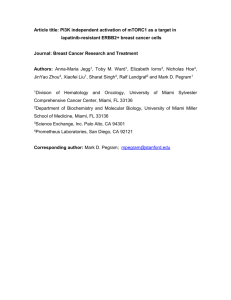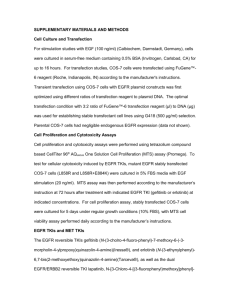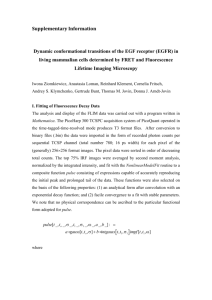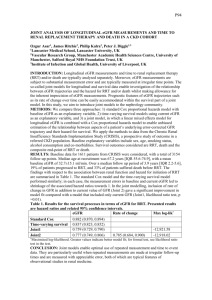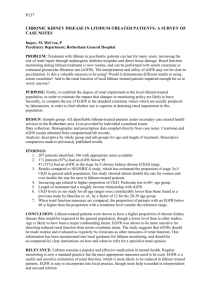Ivan_020606
advertisement
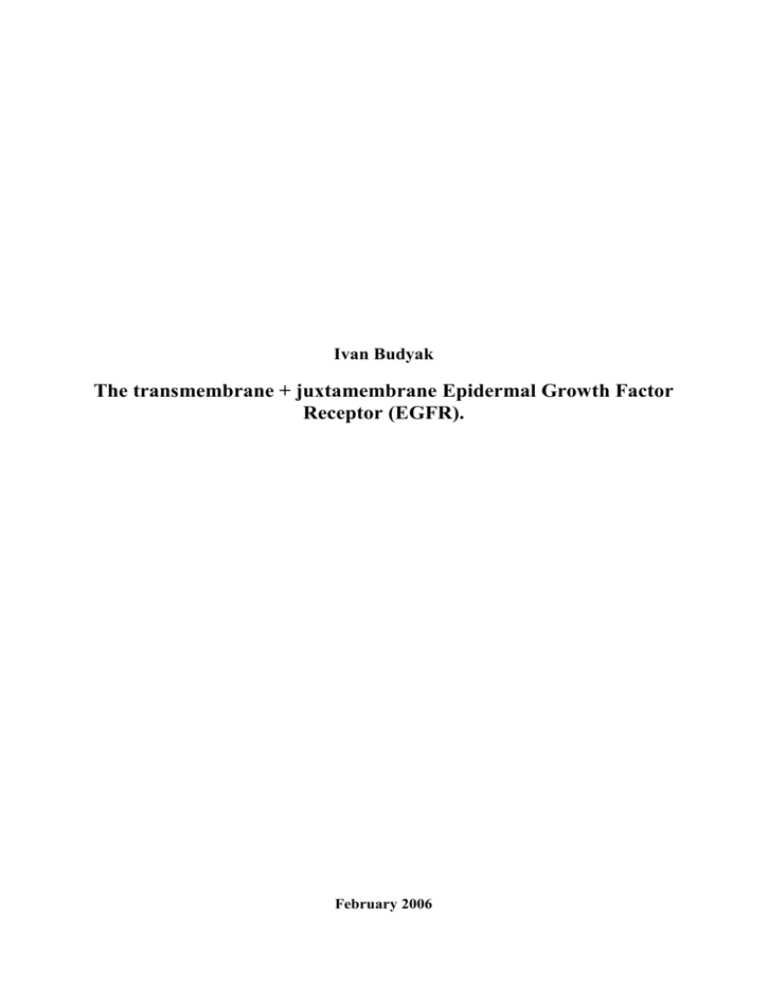
Ivan Budyak The transmembrane + juxtamembrane Epidermal Growth Factor Receptor (EGFR). February 2006 I. Introduction The epidermal growth factor receptor (EGFR) mediates many cellular responses in normal biological processes and in pathological states. It regulates the intracellular effects of ligands such as epidermal growth factor (EGF), transforming growth factor α (TGFα) and the neuregulins. The stimulation of the EGFR results in activation of multiple cell signalling pathways. It plays a critical role in the control of a host of cellular activities including cell division, differentiation and migration. EGFR overexpression or disregulation is implicated (directly and/or indirectly) in a variety of mammal cancers [1]. The EGFR subfamily consists of four closely related human receptors (the EGFR itself (also referred to as ErbB1), HER2 (or ErbB2/Neu), HER3 (or ErbB3) and HER4 (or ErbB4)) and one each from D.melanogaster and C.elegans. They can interact with each other in a ligand-dependent fashion forming heterodimers [2]. It is well established that ligand binding induces dimerization of the monomeric EGFR [3]. Thus, receptor display, dynamics, affinity and competency play important regulatory roles because the EGFR appears to exist in two different affinity classes at the cell surface [4]. The EGFR is an 1186-residue transmembrane protein with N-linked glycosylation. It is synthesized from a 1210-resudue-precursor peptide; then the signal peptide is cleaved and the protein goes into the cell membrane. The molecular mass of the EGFR is about 170 kDa [5]. By convention the EGFR is subdivided into 8 domains (fig. 1.1). The EGFR extracellular portion (or ectodomain, residues 1-621) consists of domains L1, CR1, L2 and CR2. Fig. 1.1. Schematic representation of domains of the EGFR. L1 and L2 - ligand-binding domains 1 and 2, CR1 and CR2 - cysteine-rich domains 1 and 2, JM - juxtamembrane domain, CT - carboxy-terminal domain (taken from [1]). The recently solved structure [6] shows that L1 and L2 domains responsible for ligand binding consist of so-called β-solenoid or β-helix folds. CR1 and CR2 domains consist of a number of small modules held together by disulfide bonds. Interestingly, a large loop of the CR1 domain makes contact with the CR1 domain of the other receptor in dimer. The intracellular part of the EGFR (687-1186) consists of kinase domain (that is a tyrosine-kinase) and C-terminal domain. The structure of the EGFR tyrosine-kinase domain 2 (residues 672-998) is mainly similar to other tyrosine kinases [7]; it has the ATP-binding site where the γ-phosphate can be transferred to the acceptor tyrosine residues of exogenous substrates and C-terminal domain of the EGFR (in a trans manner). The carboxy-terminal domain of the EGFR contains Tyr residues where phosphorilation modulates EGFR-mediated signal transduction. There are also some Ser/Thr residues where phosphorilation has been inferred to be important for the receptor downregulation process and sequences thought to be necessary for endocytosis. Moreover, the residues 984-996 have been identified as a binding site for actin [8] and may be involved in receptor oligomerization and clustering. The residues 622-644 are assigned to the transmembrane region in accordance with numerous prediction methods. The juxtamembrane domain (645-686) is considered to have a number of regulatory functions (e.g. in downregulation and ligand-dependent receptor internalization). The amphipathic sequence with its positive residue density is predicted to be between 653 and 661 residues [9]. NMR studies of the peptide roughly corresponding to the EGFR transmembrane domain (626-647) indicated that it is α-helical [10]. This suggests that the α-helix continues into the juxtamembrane domain. The recent findings have shown that the juxtamembrane domain is mainly α-helical in the membrane-bound state [11] and disordered in solution [12]. II. Materials and methods II.1. DNA manipulations For all manipulations with DNA E.coli strain Top10 (Novagen, Germany) was used. All enzymes were from New England Biolabs, USA. PCR procedures All constructs were amplified by standard PCR technique from the construct containing full-length human egfr in pFastBac1 (received from Dr. G.Anderson). Cloning into vectors The newly designed and amplified egfr gene regions were ligated into pBlunt (Invitrogen, USA) vector and then sequenced. pBlunt plasmids containing correct inserts were then cut by the corresponding restriction enzymes and ligated into expression vector pET 27b+ (Novagen, Germany). II.2. Transformation Transformation of E.coli A tube of frozen chemically competent cells was thawed on ice. The DNA solution (1-10 ng) was added to the competent cells and incubated on ice for 30 min. Each transformation tube was heat-pulsed for 90 sec at +42°C and placed on ice for 2 min. Room temperature S.O.C. ® (Invitrogen, USA) medium was added to each tube to a final volume of 500-1000 μl and incubated at +37°C for 60 min. 50-500 μl of each transformation were 3 spread onto LB-agar plate containing appropriate antibiotic (50 μg/ml kanamycin). Then the plates were incubated overnight at +37°C. II.3. Expression Expression in E.coli For bacterial expression E.coli BL21(DE3) Codon Plus RP (all strains from Navagen, Germany) cells transformed by the corresponding plasmid containing the gene of interest were used. For expression in flasks the cells were grown in dYT medium containing 50 μg/ml kanamycin at +37°C. When OD600 reached 0.6-0.8, IPTG (0.5 mM) was added to induce protein expression. After 4 hours of expression the cells were harvested by centrifugation (10 000g). The cell pellets were normally stored at -20°C. For expression in 5L fermenter the cells were grown in minimal medium containing 50 μg/ml kanamycin at +37°C. When OD600 reached 3-4, IPTG (0.5 mM) was added to induce protein expression and the temperature was lowered to +28°C. After 24 hours of expression the cells were harvested by centrifugation (10 000g). The cell pellets were normally stored at -20°C. II.3. Purification The cell pellet was resuspended in 300 mM NaCl, 50 mM Tris-HCl pH 8.5. The suspension was passed through a French press (SLM Aminco) and the soluble and insoluble fractions were separated by centrifugation (100 000 g, 1 h, +4°C). The pellet was resuspended in 3000 mM NaCl, 50 mM Tris-HCl pH 8.5, 4% (w/v) OG and the suspension was incubated for about 16 h at +4°C. Another centrifugation step was carried out to isolate solubilised membranes from cell debris (100 000 g, 1 h, +4°C). The supernatant was applied to a Chelating Sepharose (Amersham Biosciences) pre-loaded with Cu2+ ions and pre-equilibrated with 300 mM NaCl, 50 mM Tris-HCl pH 8.5, 0.88% (w/v) OG. The column was extensively washed with the same buffer + 50 mM imidazole, and the protein was eluted with the same buffer + 500 mM imidazole. The eluate was applied to a Strep-Tactin Sepharose (IBA, Germany) pre-equilibrated with 300 mM NaCl, 50 mM Tris-HCl pH 8.5, 0.88% (w/v) OG and immediately eluted with the same buffer + 2.5 mM D-desthiobiotin. All fractions were analyzed by SDS-PAGE and Western-blot. III. Results and discussion (the transmembrane EGFR (615-686 a.a.)) The construct was designed to contain the transmembrane domain itself (residues 626644) and the amphipathic sequence of the juxtamembrane (residues 653-661) of the EGFR as well as to carry an N-terminal 7His-tag (HHHHHHH) and C-terminal Strep-tag (WSHPQFEK). It was amplified by standard PCR, cloned into pET 27b+ vector for bacterial expression and sequenced. The expression was detected on Western-blotting for E.coli strain BL21(DE3) Codon Plus RP. The expression conditions were further optimized to obtain the highest protein yield (Fig. 3.1). 4 Fig. 3.1 His-blotting (right) and Strep-blotting (left) of crude E.coli lysates before induction (0), 4h, 16h and 24h after induction (correspondingly). The expression temperature was +37C (RED) or +28C (BLUE). The purification procedure included Me-affinity chromatography in OG as the first step immediately followed by Strep-Tactin chromatography, and then reverse phase in TFA and acetonitrile gradient (Fig. 3.2). Fig. 3.2. Purified tj-EGFR: 1 – SDS-PAGE, 2 – Hisblotting, 3 – Strep-blotting CD in detergents in lipids (Fig. 3.3) and preliminary NMR spectra in OG and SDS (data not shown) were recorded. The secondary structure prediction is in the good agreement with the presence of the transmembrane helix and random coil conformation of the juxtamembrane domain in detergent micelles. Moreover, it was possible reconstitute tj-EGFR into liposomes (data not shown), which is important for further studies of this fragment in native lipid environment. 5 Fig. 3.3. CD spectra of the tj-EGFR in water / 95% (v/v) TFE / 50 mM NaP pH 6.0, 100 mM detergent IV. References 1. Jorissen RN, Walker F, Pouliot N, Garrett TP, Ward CW, Burgess AW: Epidermal growth factor receptor: mechanisms of activation and signalling. Exp.Cell Res. 2003, 284:31-53. 2. Olayioye MA, Neve RM, Lane HA, Hynes NE: The ErbB signaling network: receptor heterodimerization in development and cancer. EMBO J 2000, 19:31593167. 3. Schlessinger J: Cell signaling by receptor tyrosine kinases. Cell 2000, 103:211-225. 4. Ullrich A, Schlessinger J: Signal transduction by receptors with tyrosine kinase activity. Cell 1990, 61:203-212. 5. Ullrich A, Coussens L, Hayflick JS, Dull TJ, Gray A, Tam AW, Lee J, Yarden Y, Libermann TA, Schlessinger J, .: Human epidermal growth factor receptor cDNA sequence and aberrant expression of the amplified gene in A431 epidermoid carcinoma cells. Nature 1984, 309:418-425. 6. Ogiso H, Ishitani R, Nureki O, Fukai S, Yamanaka M, Kim JH, Saito K, Sakamoto A, Inoue M, Shirouzu M, Yokoyama S: Crystal structure of the complex of human epidermal growth factor and receptor extracellular domains. Cell 2002, 110:775787. 7. Stamos J, Sliwkowski MX, Eigenbrot C: Structure of the epidermal growth factor receptor kinase domain alone and in complex with a 4-anilinoquinazoline inhibitor. J Biol Chem 2002, 277:46265-46272. 8. den Hartigh JC, van Bergen en Henegouwen PM, Verkleij AJ, Boonstra J: The EGF receptor is an actin-binding protein. J Cell Biol 1992, 119:349-355. 9. Seligman L, Manoil C: An amphipathic sequence determinant of membrane protein topology. J Biol Chem 1994, 269:19888-19896. 6 10. Rigby AC, Grant CW, Shaw GS: Solution and solid state conformation of the human EGF receptor transmembrane region. Biochim Biophys Acta 1998, 1371:241-253. 11. Choowongkomon K, Carlin CR, Sonnichsen FD: A structural model for the membrane-bound form of the juxtamembrane domain of the epidermal growth factor receptor. J Biol.Chem 2005, 280:24043-24052. 12. Choowongkomon K, Hobert ME, He C, Carlin CR, Sonnichsen FD: Aqueous and micelle-bound structural characterization of the epidermal growth factor receptor juxtamembrane domain containing basolateral sorting motifs. J Biomol.Struct.Dyn. 2004, 21:813-826. 7
